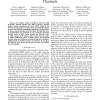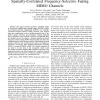93 search results - page 3 / 19 » Maximum Entropy MIMO Wireless Channel Models |
CISS
2011
IEEE
12 years 8 months ago
2011
IEEE
—Mobile optical wireless has so far been limited to very short ranges for high data rate systems. It may be feasible to overcome the data rate limitations over large transmission...
CORR
2008
Springer
13 years 4 months ago
2008
Springer
Two distinct models of feedback, suited for FDD (Frequency Division Duplex) and TDD (Frequency Division Duplex) systems respectively, have been widely studied in the literature. In...
GLOBECOM
2006
IEEE
13 years 10 months ago
2006
IEEE
— This paper presents non-linear precoding design in closed-loop multiple-input multiple-output (MIMO) orthogonal frequency-division multiplexing (OFDM) over spatiallycorrelated,...
GLOBECOM
2007
IEEE
13 years 11 months ago
2007
IEEE
— Adaptive transceivers play an important role in wireless communications and the design of MIMO systems. Therefore models that enable simulation of dynamic and time varying chan...
ICC
2007
IEEE
13 years 11 months ago
2007
IEEE
— In most wireless communications research, the channel models considered experience less severe fading than the classic Rayleigh fading case. In this work, however, we investiga...


